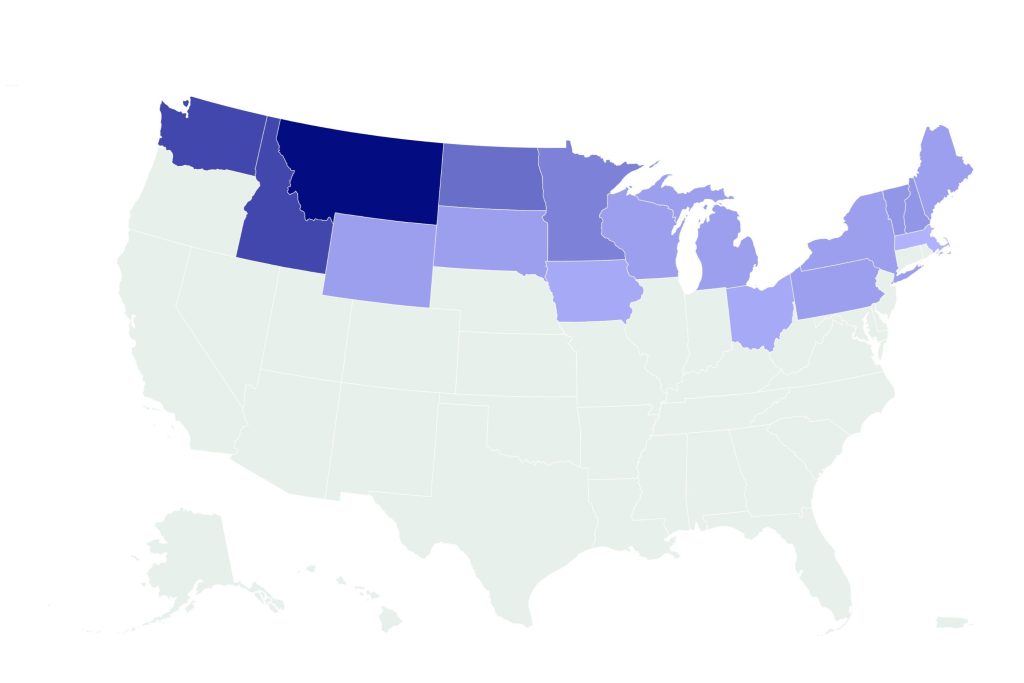The northern United States recently experienced a widespread snowfall event, impacting at least 17 states. The National Weather Service (NWS) tracked snowfall accumulations over a 24-hour period, revealing significant variations in snowfall totals across the affected region. Montana bore the brunt of the storm, recording an impressive 18 inches of snow in isolated areas. Idaho and Washington followed closely with 12 inches, highlighting the intensity of the snowfall in the northwestern part of the country. Further east, North Dakota measured 8 inches, while Minnesota saw 6 inches of accumulation. The northeastern states, including Vermont and New Hampshire, experienced lighter snowfall, reaching up to 4 inches. Several other states, spanning from Wyoming to Maine, recorded around 3 inches of snow. Lighter accumulations were observed in Ohio (2 inches), Iowa, and Massachusetts (1 inch). This widespread snowfall prompted winter weather advisories and even winter storm warnings across several states, underscoring the significance of the event.
The impact of this storm was felt across various regions. Winter storm warnings, issued by the NWS when hazardous winter weather is imminent or occurring, were in effect for parts of Minnesota and Wisconsin. These warnings emphasize the potential for disruptive conditions and the need for preparedness. The snowfall created challenging travel conditions, particularly in areas with heavier accumulations. Reports from various locations described messy highways and slow commutes, highlighting the impact on daily life and transportation. The storm, arriving during the early morning hours, further complicated travel, particularly the morning commute. Meteorologists cautioned residents to exercise caution and be prepared for potentially dangerous road conditions, particularly due to the risk of black ice forming from freezing rain.
Meteorologists closely monitored the storm’s progress and provided updates via various platforms, including social media. Predictions included the development of isolated mountain snow and valley wintry mix showers, particularly in northwestern Montana. Concerns were raised regarding the potential for black ice, urging commuters to exercise extra vigilance. In the Twin Cities region, the possibility of another storm system on Sunday was noted, although significant snowfall was deemed unlikely. Reports from various locations described the increasing snow accumulation and its impact on road conditions, reinforcing the need for caution.
Social media posts from meteorologists and broadcasters provided real-time updates and insights into the unfolding weather event. These posts highlighted the storm’s progress, the worsening conditions, and the impact on travel. They also served as a platform to disseminate safety reminders and encourage preparedness. The shared experiences and observations from individuals in different locations offered a comprehensive picture of the storm’s impact across the affected areas.
The duration of the winter storm warnings varied depending on the region. In parts of Wisconsin, the warnings were in effect until 9 a.m. CST on Friday morning, indicating a shorter duration compared to other areas. The NWS continued to monitor the situation and provide updates as needed, ensuring that residents had access to the latest information. The varying snowfall amounts and the duration of the warnings highlight the dynamic nature of this weather event and the importance of localized information.
This widespread snowfall event, impacting a significant portion of the northern United States, brought with it a host of challenges. From travel disruptions to potential hazards like black ice, the storm underscored the importance of preparedness and heeding warnings from meteorological agencies. The collective efforts of meteorologists, broadcasters, and individuals sharing information via various platforms played a crucial role in keeping the public informed and safe during this winter weather event. The varying snowfall amounts across the affected region further emphasized the need for localized information and vigilance, ensuring that communities could respond effectively to the specific challenges they faced.










